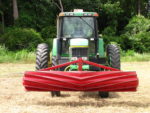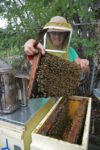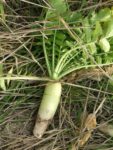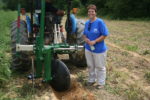Showing 21-40 of 43 results
Exploring Energy Efficiency and Alternatives Curriculum
According to Sarah Hamlen, Montana State University Extension, and Milton Grieger, University of Wyoming Extension, Western producers’ profitability is closely linked to the consumption and production of energy resources. Decisions made by these producers on energy issues have long-term implications for the sustainability of agricultural production, they assert. To increase producers’ knowledge of energy issues, […]

Good Natured Family Farms Brings Together Producers and Local Businesses to Market Local Foods
Good Natured Family Farms is an alliance of more than 150 family farms and small businesses in the Kansas City, MO area. They sell products under the Good Natured Family Farms’ logo in Balls Food Stores in the Kansas City Area. Their selection of products encompasses all-natural beef, free-range chickens, free-range brown eggs, farmhouse cheeses, milk, eggnog, […]
Researchers and Educators Collaborate to Teach Youth about Cover Crops
Across the region, farmers are planting cover crops, a method of revitalizing soil, curbing erosion, and managing pests. Steve Sutera, an Extension educator at South Dakota State University (SDSU), saw an opportunity to bring together Bon Homme County’s Extension service, FFA Chapter, 4-H Club, and ongoing research at SDSU. In 2008, Sutera submitted a proposal […]
Using Hydroponic Green Forage to Reduce Feed Costs in Natural Pork Production
Due to the rising cost of feed, many small scale pork producers are exploring alternatives in order to increase their profit margins. At Donnelly Farms, Jack Donnelly is producing hydroponically-grown green forage for his hogs, and has been able to reduce feed outlay and increase their bottom line. Donnelly Farms is a small, family-owned farm […]
Sustainable Renewable Energy Training for Agriculture and Natural Resource Professionals
The multiple benefits that a sustainable bioenergy system can provide underscore the need for its development in a manner that assures that the expansion of this sector provides not just new energy but broader environmental and community benefits as well (Kleinschmit, 2007; Jordan et al, 2007; Kleinschmit and Muller, 2005). It will require that farmers […]
Educational Curricula and Professional Development Training for Energy Efficient Production Practices
In response to the shift in some crop acres from providing food and fiber to an increased emphasis in energy farming, concerns have been raised about potential problems from crop monocultures or high rates of residue removal. David Clay’s long-term goals for his project were to increase producers’ awareness of the importance of determining costs […]
Impact of Biomass Removal for Bioenergy
The rapid increase in ethanol production from corn rain, and the proposed use of crop residues for ethanol production poses significant challenges in increasing awareness and providing needed training to extension educators and agency staff to address the potential environmental impacts of intensive corn production and corn residue use. Mahdi Al-Kaisi conducted an educational training […]
Greenhouse Energy Conservation Strategies and Alternative Fuels
Many greenhouse growers are looking for options to reduce their energy costs, but they don’t always understand which options will provide the greatest return on investment. For his project, Scott Sanford developed curriculum materials, extension bulletins, resource lists, and a spreadsheet model for educators to use for delivering programming on energy management and conservation for […]

Biofuels and Community Participation
Extension and other natural resource educators can provide educational programming on renewable energy and potential impacts at the community level, and can be facilitators of community discussions about renewable energy. Sharon Lezberg provided training materials to approximately 100 extension, NRCS educators, and community stakeholders on ways to engage community members and stakeholders in assessing proposed bioenergy developments. The toolkit Lezburg developed provides a decision-making […]
Integrated Alternative Energy and Livestock Production Systems
Agricultural production capacity, as well as transportation, storage, and marketing infrastructure for alternative biomass feedstocks and other renewable energy sources often presents challenges. In some cases, farmers and ranchers can find themselves at a disadvantage, operating in a knowledge vacuum as they encounter developers moving to position themselves for future energy development. Michael Siepel’s project […]
Storage and Utilization of Ethanol Co-Products by Small Cattle Operations
While perennial biomass crops have both environmental and energy benefits over corn ethanol, there are limited commercialscale facilities utilizing biomass feedstocks for liquid fuel production. The expansion of corn ethanol has provided Nebraska with several million tons of animal feeds from ethanol co-products annually. According to Francis John Hay, these ethanol co-product feeds have excellent […]
Iowa Student Studies Woodchip Bioreactors for Nitrate Reduction in Agricultural Drainage
Tile drainage reduces soil moisture levels for optimal crop growth, but there is concern about nitrate loss from these systems. Because the water quality of regional streams, rivers, and lakes can be negatively impacted by nitrate in drainage, researchers at Iowa State University are studying several practices that can be done to reduce the amount […]
Researchers Study Forage Chicory for Parasite Reduction in Sheep
Sheep and goat production is a growing enterprise for small and limited resource farmers in the North Central region. While small ruminants (sheep and goats) are adaptable to many different production systems and can be raised with relatively few inputs, they present production challenges. For instance, control of internal parasites, especially gasrointestinal nematodes including Haemonchus […]

Grant Puts (Good) Crimp in Farm Operations
It all began in 2002 with a $6,500 SARE grant and the seed of an idea. Today, that idea has grown into hundreds of research projects around the country, an international business and a new, effective no-till tool that farmers are adding to the ways they suppress weeds in cash-crop fields. The tool is the […]

Cutting Edge Research: Helping Bees Help Themselves
Diseases, pests and the mysterious phenomenon of colony collapse disorder pose a dire threat to the U.S. beekeeping industry and, in turn, to the $20-billion-a-year crop industry that relies on insect pollination. Because of these increasing pressures, the ranks of managed bee colonies have plummeted in recent years: On average, beekeepers are losing 30 percent […]

Dryland Cover Cropping Boosts Yields
Every drop of water counts for farmers who practice dryland cultivation, a practice that relies on rainfall without the benefit of irrigation. So, when it comes to incorporating cover crops into a dryland rotation, many farmers hesitate, wondering: “How much moisture is the cover crop going to demand, and will I pay for it later […]

The Lucrative Sweet Potato Takes Root
Small-scale tobacco farmers in eastern Kentucky who are looking for alternatives due to changes in the tobacco market are discovering that a relatively easy, often profitable transition lies in sweet potatoes. With relatively low input and capital costs and a short learning curve, they are able to earn gross returns of up to $7,000 per […]
Food Hubs: The Next Evolution in Local Markets?
If you think the local foods movement is just a fad, think again. For the first time, the U.S. Department of Agriculture has included restaurants and grocery store sales in its local food markets survey, and the sales are hard to ignore: nearly $5 billion a year in fruits and vegetables from local farmers. That […]
Low-Till Forage Production
To fill their need for year-round, inexpensive forages, California dairy producers typically plant and harvest a series of forage crops: small grains, corn for silage, milo and sorghum sudan. While this requires considerable tillage and seed-bed preparation ahead of each successive crop, the production systems lend themselves to conservation tillage approaches developed in other regions. […]
Vegetables All Year in Northern New Mexico
Thanks to the effort of two New Mexico State University faculty members and a SARE grant, the farmers of northern New Mexico are finding that vegetables can be successfully grown year-round in high tunnel greenhouses. Del Jiminez and Steve Guldan of the Alcalde Research Center received a SARE grant to construct different designs of high […]